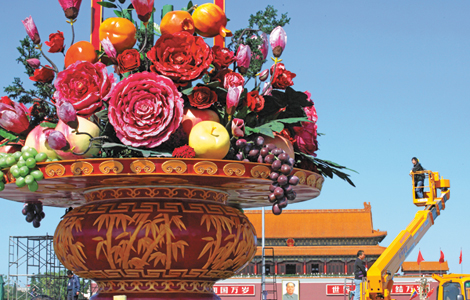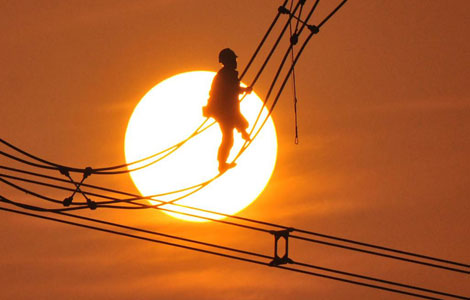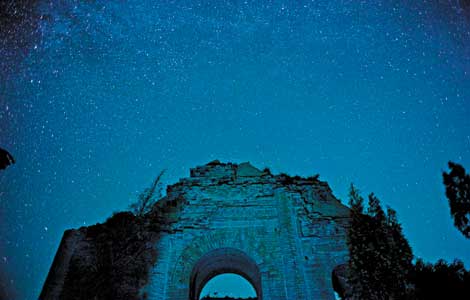Catholic conclave abides in Tibetan village
Updated: 2013-10-05 07:35
By Liu Xiangrui, Wang Huazhong and Daqiong (China Daily)
|
||||||||
Catholic traditions
Families in the village keep the Bible and other works translated into Tibetan language by foreign missionaries at home. They recite the Bible and psalms in the local dialect during gatherings.
Though their daily life is not different from the Buddhists in the area, they follow Catholic traditions in funerals and names of their children.
A separate cemetery near the village is the resting place for many local Catholics.
Villagers normally invite a priest from Yunnan to perform funeral ceremonies. A tombstone with the deceased's name differs from the Buddhist tradition of no such markers.
Lorendy, 43, was the first Catholic priest in Tibet since the 1940s.
Raised in a Catholic family, he was trained at the Chinese Catholic Academy of Theology and Philosophy in Beijing.
He returned and became a priest in 1996, ending a long period of there being no priest in Upper Yanjing. Before the 1940s, 17 foreign priests had served at the church.
He was mainly involved in performing Catholic ceremonies such as funerals.
"It's been a tradition that Buddhists follow their own ways while we Catholics do it in the Catholic way," Lorendy explained.
But ceremonies too have inevitably absorbed local features, he added.
When a new statue is completed in the church, Catholic villagers offer hada just as Buddhists do.
Weddings are normally held at home. The ceremony is simple, usually having senior Catholics recite passages from the Bible. Lorendy's niece Mary is one of the few who had a wedding ceremony following Catholic customs in the church. Her husband is also a Catholic.
"We had heard about such weddings before. But no one had really seen one," recalled Mary, now 35.
She said the church was packed with people that day. "I felt nervous, but it was also very special."
Two religions
In Upper and Lower Yanjing, it's not difficult to find families whose members have different beliefs.
Like many Tibetan homes, Zaxi Wangdui's living room has a shrine. But the figures are of Christ and the Madonna. Zaxi Wangdui's Buddha statue sits on the left side of the shrine. He is a Buddhist devotee, while his wife Maria and their three children are Catholics.
Maria's family has a long Catholic tradition. Maria is both her Christian name and name in daily use. Many other people in the village have Christian names, she said.
In traditional Tibetan attire, the 61-year-old visits the church every morning. She also prays before the saints' images at home every morning and evening.
From behind the Buddha statue, Zaxi Wangdui takes out his Buddhist scriptures and chants them every night.
"We have gotten used to it and are always at peace. We understand and help each other, and I don't mind being the religious minority in the family," Zaxi Wangdui said with a smile.
He joins Maria in church activities when a priest visits and every Christmas he volunteers to cook at the church. He and other Buddhist villagers also participate in the celebration dance.
Maria helps cook meals and takes off all her hair decorations according to local Buddhist tradition when Zaxi Wangdui invites lamas home for prayer.
There are adaptations when people of different beliefs form a new family, Zaxi Wangdui said.
When Zaxi Wangdui's Buddhist relatives visited their home in the past, he would inform them about some Catholic customs, including not eating meat on Fridays.
"But few young people here consider religious differences a problem when they marry," Soinam Wangmo said.
In the past, Zaxi Wangdui's children went either with Maria to church for prayer or with him on pilgrimage to the monastery.
"As parents, we don't interfere with their religious beliefs. We'll just let them decide it when they grow up," Zaxi Wangdui explained.

 Victoria Beckham S/S 2014 presented during NYFW
Victoria Beckham S/S 2014 presented during NYFW
 'Despicable' minions upset Depp's 'Lone Ranger' at box office
'Despicable' minions upset Depp's 'Lone Ranger' at box office
 'Taken 2' grabs movie box office crown
'Taken 2' grabs movie box office crown
 Rihanna's 'Diamonds' tops UK pop chart
Rihanna's 'Diamonds' tops UK pop chart
 Fans get look at vintage Rolling Stones
Fans get look at vintage Rolling Stones
 Celebrities attend Power of Women event
Celebrities attend Power of Women event
 Ang Lee breaks 'every rule' to make unlikely new Life of Pi film
Ang Lee breaks 'every rule' to make unlikely new Life of Pi film
 Rihanna almost thrown out of nightclub
Rihanna almost thrown out of nightclub
Most Viewed
Editor's Picks

|

|

|

|

|

|
Today's Top News
China tops APEC CEOs' picks for investment: survey
Man burns self on National Mall in Washington DC
UN aviation body reaches deal on carbon emissions
Republicans hang tough in standoff over shutdown
Italy's senate panel votes Berlusconi's expulsion
China, Malaysia to boost ties
ZTE aims at bigger share in neighbors
Li's East Asian visit will boost co-op
US Weekly

|

|






